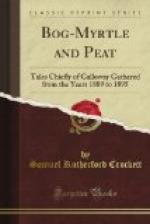II. THE ROAD TO THE KIRK
The clean red farm-cart rattled into the town of Cairn Edward at five minutes past eleven. The burghers looked up and said, “Hoo is the clock?” Some of them went so far as to correct any discrepancy in their time-keepers, for all the world knew that the Drumquhat cart was not a moment too soon or too late, so long as Saunders had the driving of it. Times had not been too good of late; and for some years—indeed, ever since the imposition of the tax on light-wheeled vehicles—the “tax-cart” had slumbered wheelless in the back of the peat-shed, and the Drumquhat folk had driven a well-cleaned, heavy-wheeled red cart both to kirk and market. But they were respected in spite of their want of that admirable local certificate of character, “He is a respectable man. He keeps a gig.” One good man in Whinnyliggate says to this day that he had an excellent upbringing. He was brought up by his parents to fear God and respect the Drumquhat folks!
Walter generally went to church now, ever since his granny had tired of conveying him to the back field overlooking the valley of the Black Water of the Dee, while his mother made herself ready. He was fond of going there to see the tents of the invading army of navvies who were carrying the granite rock-cuttings and heavy embankments of the Portpatrick Railway through the wilds of the Galloway moors. But Mary M’Quhirr struck work one day when the “infant,” being hungry for a piece, said calmly, “D’ye no think that we can gang hame? My mither will be awa’ to the kirk by noo!”
On the long journey to church, Walter nominally accompanied the cart. Occasionally he seated himself on the clean straw which filled its bottom; but most of the time this was too fatiguing an occupation for him. On the plea of walking up the hills, he ranged about on either side of the highway, scenting the ground like a young collie. He even gathered flowers when his grandfather was not looking, and his mother or his “gran,” who were not so sound in the faith, aided and abetted him by concealing them when Saunders looked round. The master sat, of course, on the front of the cart and drove; but occasionally he cast a wary eye around, and if he saw that they were approaching any houses he would stop the cart and make Walter get in. On these occasions he would fail to observe it even if Walter’s hands contained a posy of wild-flowers as big as his head. His blindness was remarkable in a man whose eyesight was so good. The women-folk in the cart generally put the proceeds of these forays under the straw or else dropped them quietly overboard before entering Cairn Edward.
The old Cameronian kirk sits on a hill, and is surrounded by trees, a place both bieldy and heartsome. The only thing that the Cameronians seriously felt the want of was a burying-ground round about it. A kirk is never quite commodious and cheery without monuments to read and “thruchs” to sit upon and “ca’ the crack.” Now, however, they have made a modern church of it, and a steeple has been set down before it, for all the world as if Cleopatra’s needle had been added to the front wall of a barn.




